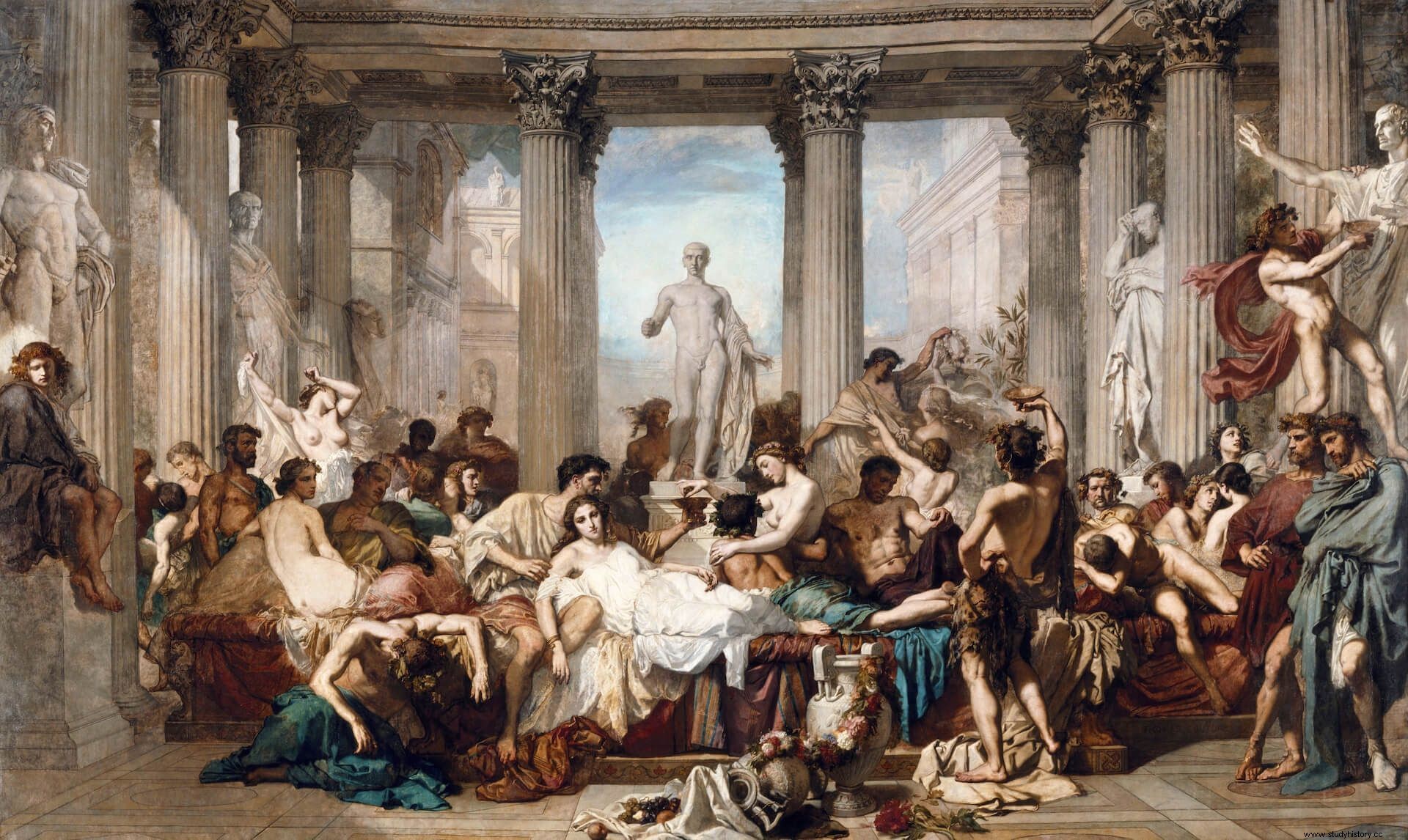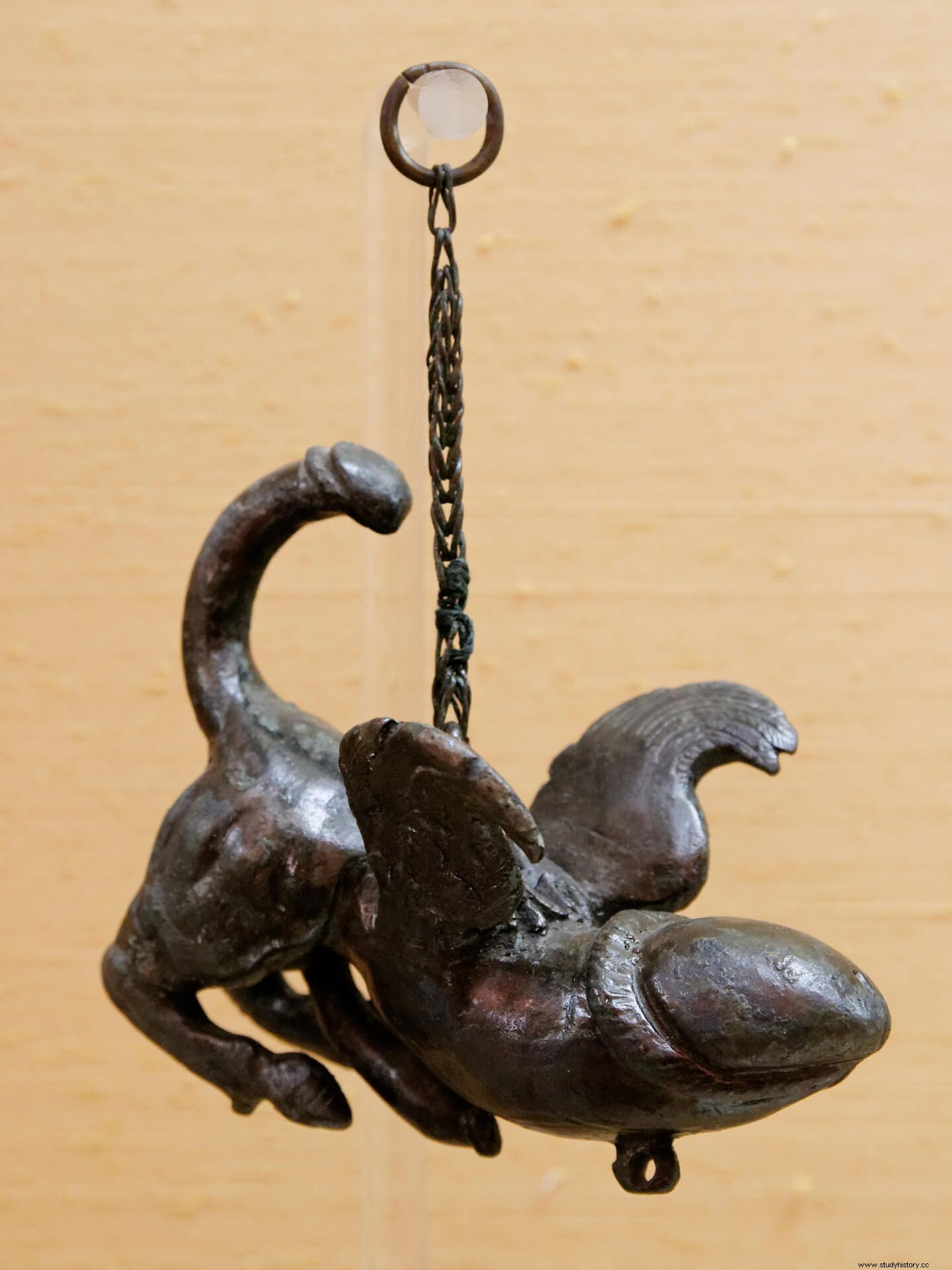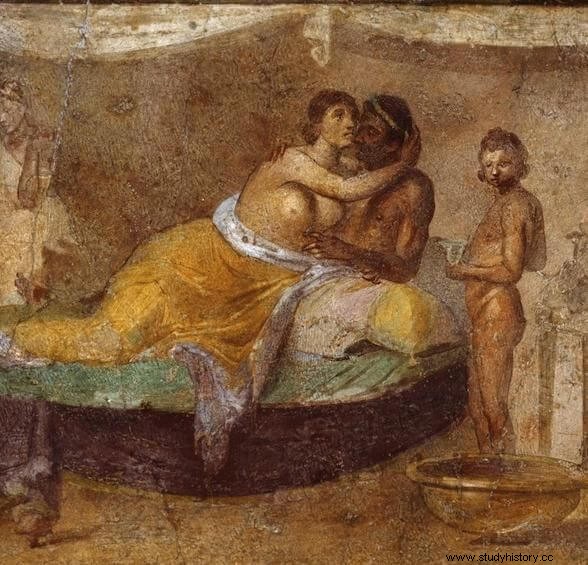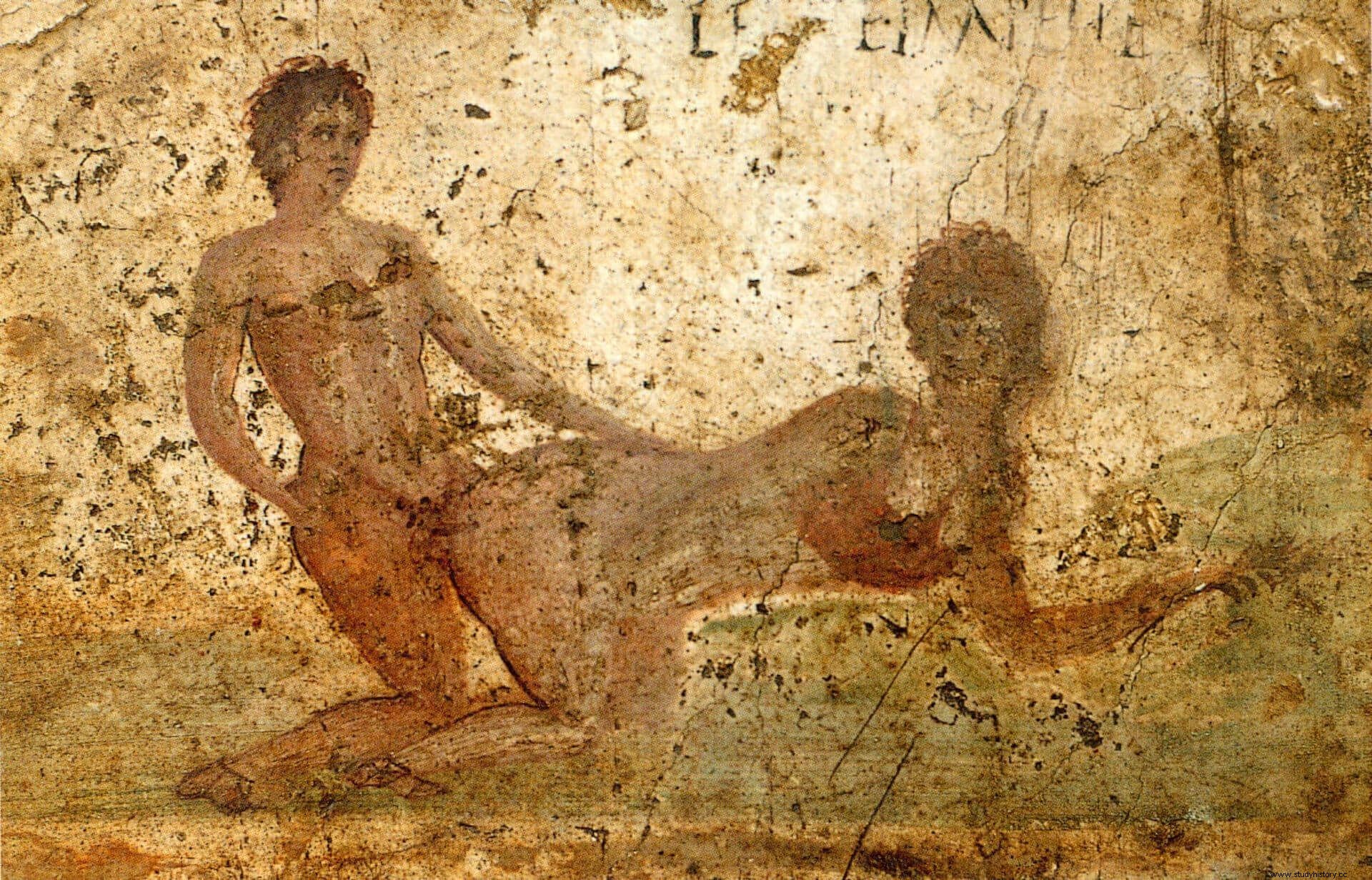
Largely from an overly literal reading of the sources, but also of the use that has been made of these texts in art and contemporary popular culture, especially in the cinema. The works referring to the lives of the emperors, from Suetonius to Tacitus, Dion Cassius or the authors of the Augusta History , they tell us about sexual excesses in the imperial court . Thus, we can see the "little fish", very young children trained to be used sexually by Tiberius in the bath, Caligula committing incest with his sister or Nero with his mother, the wives of senators being forced at banquets (see « The Roman banquet and its excesses»in Archeology and History #8:Rich in Rome ) by the emperors or brothels filled with citizens and set up for the imperial festivities. The famous ships of Lake Nemi have been associated, precisely, with Caligula's parties, abundant in alcohol and sex. Nero, disguised as an animal, is also described sexually abusing and biting the genitalia of young men tied to poles.
This extended, in Latin works, to criticism of other characters, such as Hostio Cuadra, mentioned by Seneca , for organizing orgies and covering the rooms with curved mirrors to see the size of the genitals increased. The same can be seen in the works of Juvenal or Catullus , in which sexually active and drunk women, men who seduced the wives of others, or who dressed in transparent silks are censored.
This perception is heightened by the enormous visibility of sexuality and genitality in the Roman world, with sexual scenes in the lanterns and other objects (such as the well-known Warren Cup), phallus-shaped amulet necklaces, tintinnabuli (bells) with the same shape, spintriae or tokens with sexual iconography and debated function or the presence of penises on the walls, whether they were signs for brothels or that functioned as talismans (see «Graffiti and graffiti. Social networks in Pompeii» in Arqueología e Historia #24:The Last Days of Pompeii ). The well-known wall paintings of Pompeii, both in the brothel and in the baths, depicting sex scenes, have been repeated over and over again.

But we must ask how much truth there is in these stories , generally built a posteriori and after the death of these emperors, by writers who wrote from a moralizing point of view and who saw imperial power as a danger to senatorial authority. Likewise, philosophical currents such as Stoicism (which would strongly influence both Christianity and favor its acceptance among the Roman elite), which emphasized temperance and the containment of passions, as well as the rejection of pleasures worldly, they found in the criticism of an exuberant sexuality a very convenient commonplace.
Sex in Rome, a question of gender or power?
In addition, it must be taken into account, as a starting point, that Roman sexuality cannot be understood within the current categories of sexual orientation. There was no concept of heterosexuality, homosexuality or bisexuality as today, but a hierarchy, which conditioned the acceptability of activity or passivity. Thus, people of higher rank had to exercise an active sexuality (free men, citizens and employers), compared to subordinates, who "received" sex passively (women, slaves, freedmen). This referred to both initiative and who penetrated and even who moved or postures. And we must bear in mind that, for the Romans, with a deeply patriarchal society, the inferior element by nature was the woman, the feminization of a man was considered an element of degradation.

A purely political and reproductive marriage was also imposed. It was not expected that there would be love, although a certain marital concord was reached and affection could arise. And, of course, passion or any kind of equality in decision-making was dismissed as harmful. Of course, in this marriage, while for women any extramarital sexuality was prohibited. , and non-reproductive marriage looked bad, the man could have all the sex he wanted as long as he didn't go with another married woman or a marriageable daughter under his paternal authority. They could access prostitutes and slaves of both sexes (see "Use and abuse of slaves in Ancient Rome" in Archeology and History #8:Rich in Rome ), demand sex from freedmen (unless she was a married freedwoman), or freely have sex with people with a note of infamy, such as actresses or gladiators, or with foreigners.
Anything that broke these rules was considered infamous and “against” nature. Thus, precisely, sexual behavior was one of the simple ways, for the Romans, to politically attack the opposite. They are morbid elements, complicated to verify and that feminize or defame the enemy, at a time when the feminine was considered essentially inferior. It must be remembered that, even today, the idea survives, in certain sectors, that "passivity" is something feminine, associated with the pen in homosexuality, and considered unmasculine in the face of initiative and "activity", or the association from a sexually active woman to prostitution.
This idea is framed, for example, Nero's romance with two of his slaves / freedmen. The first, Sporus, would have been castrated by Nero, who found it attractive because of her resemblance to Poppea Sabina, the emperor's second wife, to whom he would have caused her death while pregnant, after kicking her in the belly. The second, whom the sources call Pythagoras or Doryphorus, would act actively, while Nero would literally imitate the screams of the girls being deflowered. To this would be added, in the sources, that Nero would have married both, breaking with the marriage tradition, in a kind of mockery of the mos maiorum . This allows us to see the investment construction of what is considered acceptable , as criticism of the emperor. It is not homoerotic relationships that are criticized, but passivity, the castration of the slave and the mockery of marriage. The Romans use this reversal of the usual as a way of suggesting that the emperor would also have exchanged a good government for a bad one. The same happens with the rest of the excesses or breaches of the norm that have been mentioned.
Wives and prostitutes
We can also see another significant detail, that of the mention of the imitation of the screams of young women on their wedding night. It must be taken into account that the age of marriage for girls was twelve years and that, even so, there are epigraphic remains of girls who died when they were only nine or ten years old who were already married or who had died in childbirth. . Octavia, Nero's first wife married at about eleven years old, and Agrippina, his mother at no more than twelve. Many times these weddings would be with men older than them, who married in second marriages, who did not see the need to be delicate or take into account the pleasure of their sexual partners, accustomed to abusing slaves or going to prostitutes. 
The idea of consent was something that simply It did not fall within the Roman parameters and sex was, for citizen women, an obligation within marriage and, outside of it, a crime punishable by exile or death. Plutarch also refers to how unpleasant or painful wedding nights could be, comparing marriage to collecting honey, in which, to enjoy it, one had to go through the prior pain of stings.
Regarding dealing with prostitutes It must be taken into account that these would be, for the most part, slaves, used to exhaustion. Prostitution was a normalized element in daily life, with brothels in the center of the city and a large presence of street prostitutes, who would be located around the baths, forums and entertainment buildings. The prices, from what we see in the texts or in the graffiti of Pompeii (see «Beds of work. The sex business in Pompeii» in Arqueología e Historia #2:Rome's Underworld ), were, in general, quite cheap, so that the prostitutes would have to perform a large number of services per night to cover the minimum needs. Violence, hunger and misery would be an everyday occurrence except for a lucky few. It would also be the continuous pregnancies and abortions, or infanticide in case of not being able to end the pregnancy. The graves with the remains of newborns (many of them male, contrary to the usual trend of primarily female infanticide) in Hambleden (England) or Ashkelon (Israel) have been associated with nearby brothels.

The Romans readily accepted the use of those that they were considered little more than objects, although excessive use was criticized or the dangers of infatuation with them were warned. What was unacceptable was treating prostitutes as wives or wives as prostitutes, hence the reference to female citizens forcibly prostituted or prostitutes or "dishonest" women taken as wives. This criticism can be seen in Caligula's exhibition of his wife Cesonia, naked, before his friends.
In conclusion, for the Roman authors the reference to an excessive or inverted sexuality with respect to the norm , which has made such an impression on our society (and which can be seen reflected in the use of the historical theme for pornography or in movies like Caligula , by Tinto Brass, or the Satiricon , by Fellini), functioned as a social criticism, as a metaphor for an equally excessive and immoderate government. Many of the sex in Rome stories would range between exaggeration and outright fabrication. However, within a sexual norm in which the male had a very wide freedom to sexually exploit others, without taking into account another desire beyond his own, the complaint of the elite regarding the emperor was that he behaved with them, precisely , as they behaved with prostitutes, male and female slaves.
Bibliography
Cantarella, E. (1991):According to nature. Bisexuality in the ancient world , Madrid:Akal.
Hallett, J.P. and Skinner, M.B.(1997):Roman Sexualities . Princeton:Princeton University Press.
Knapp, R. C. (2011):The forgotten of Rome. Prostitutes, outlaws, slaves, gladiators and ordinary people . Barcelona:Ariel.
Rawson, B. (ed.) (2010):A Companion to Families in the Greek and Roman Worlds . Oxford:Blackwell Publishing Ltd.
